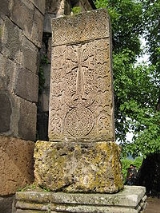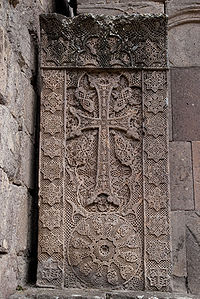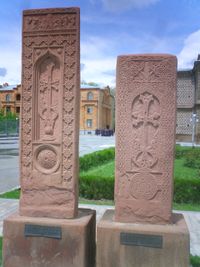
Khachkar
Encyclopedia
| Khachkar |
 |
 |
A khachkar or khatchkar is a carved, cross-bearing, memorial stele
Stele
A stele , also stela , is a stone or wooden slab, generally taller than it is wide, erected for funerals or commemorative purposes, most usually decorated with the names and titles of the deceased or living — inscribed, carved in relief , or painted onto the slab...
covered with rosette
Rosette (design)
A rosette is a round, stylized flower design, used extensively in sculptural objects from antiquity. Appearing in Mesopotamia and used to decorate the funeral stele in Ancient Greece...
s and other botanical motifs. Khachkars are characteristic of Medieval Christian
Christian
A Christian is a person who adheres to Christianity, an Abrahamic, monotheistic religion based on the life and teachings of Jesus of Nazareth as recorded in the Canonical gospels and the letters of the New Testament...
Armenian art found in Armenia
Armenia
Armenia , officially the Republic of Armenia , is a landlocked mountainous country in the Caucasus region of Eurasia...
.
Description
The most common khachkar feature is a crossCross
A cross is a geometrical figure consisting of two lines or bars perpendicular to each other, dividing one or two of the lines in half. The lines usually run vertically and horizontally; if they run obliquely, the design is technically termed a saltire, although the arms of a saltire need not meet...
surmounting a rosette
Rosette (design)
A rosette is a round, stylized flower design, used extensively in sculptural objects from antiquity. Appearing in Mesopotamia and used to decorate the funeral stele in Ancient Greece...
or a solar disc. The remainder of the stone face is typically filled with elaborate patterns of leaves, grape
Grape
A grape is a non-climacteric fruit, specifically a berry, that grows on the perennial and deciduous woody vines of the genus Vitis. Grapes can be eaten raw or they can be used for making jam, juice, jelly, vinegar, wine, grape seed extracts, raisins, molasses and grape seed oil. Grapes are also...
s, pomegranate
Pomegranate
The pomegranate , Punica granatum, is a fruit-bearing deciduous shrub or small tree growing between five and eight meters tall.Native to the area of modern day Iran, the pomegranate has been cultivated in the Caucasus since ancient times. From there it spread to Asian areas such as the Caucasus as...
s, or abstract knotwork. Occasionally a khachkar is surmounted by a cornice with biblical
Bible
The Bible refers to any one of the collections of the primary religious texts of Judaism and Christianity. There is no common version of the Bible, as the individual books , their contents and their order vary among denominations...
or saintly figures.
Most early khachkars were erected for the salvation of the soul of either a living or a deceased person. Otherwise they were intended to commemorate a military victory, the construction of a church, or as a form of protection from natural disasters.
The most common location for early khachkars was in a graveyard. However, Armenian gravestones take many other forms, and only a minority are khachkars.
History
The first true khachkars appeared in the 9th century, during the time of ArmenianArmenians
Armenian people or Armenians are a nation and ethnic group native to the Armenian Highland.The largest concentration is in Armenia having a nearly-homogeneous population with 97.9% or 3,145,354 being ethnic Armenian....
revival after liberation from Arab
Arab
Arab people, also known as Arabs , are a panethnicity primarily living in the Arab world, which is located in Western Asia and North Africa. They are identified as such on one or more of genealogical, linguistic, or cultural grounds, with tribal affiliations, and intra-tribal relationships playing...
rule. The oldest khachkar with a known date was carved in 879 (though earlier, cruder, examples exist). Erected in Garni
Garni
Garni is a village in the Kotayk Province of Armenia, situated approximately 28 km southeast from Yerevan.- History :...
, it is dedicated to queen Katranide, the wife of king Ashot I Bagratuni. The peak of the khachkar carving art was between the 12th and the 14th centuries. The art declined during the Mongol
Mongols
Mongols ) are a Central-East Asian ethnic group that lives mainly in the countries of Mongolia, China, and Russia. In China, ethnic Mongols can be found mainly in the central north region of China such as Inner Mongolia...
invasion at the end of the 14th century. It revived in the 16th and 17th centuries, but the artistic heights of the 14th century were never achieved again. Today, the tradition still remains, and one can still see khachkar carvers in some parts of Yerevan
Yerevan
Yerevan is the capital and largest city of Armenia and one of the world's oldest continuously-inhabited cities. Situated along the Hrazdan River, Yerevan is the administrative, cultural, and industrial center of the country...
.
About 40,000 khachkars survive today. Most of them are free standing, though those recording donations are usually built into monastery walls. The following three khachkars are believed to be the finest examples of the art form:
- One in GeghardGeghardFor the town, see Geghard, Armenia.The monastery of Geghard is a unique architectural construction in the Kotayk province of Armenia, being partially carved out of the adjacent mountain, surrounded by cliffs...
, carved in 1213, probably by master Timot and master Mkhitar - The Holy Redeemer khachkar in HaghpatHaghpatHaghpat is a village in the Northern Lori province of Armenia, close to the city of Alaverdi and the state border with Georgia.It is notable for Haghpat Monastery, a religious complex founded in the 10th century and included in the UNESCO World Heritage List along with monasteries in nearby Sanahin...
(see gallery), carved in 1273 by master Vahram - A khachkar in GoshavankGoshavankGoshavank is a 12-13th century Armenian monastery located in the village of Gosh in the Tavush Province of Armenia. Today the monastery is not a functioning religious complex, although it remains a popular tourist destination and has recently undergone some light restoration...
, carved in 1291 by master Poghos).
A number of good examples have been transferred to the Historical Museum in Yerevan
Yerevan
Yerevan is the capital and largest city of Armenia and one of the world's oldest continuously-inhabited cities. Situated along the Hrazdan River, Yerevan is the administrative, cultural, and industrial center of the country...
and beside the cathedral in Echmiadzin
Echmiadzin
Mother Cathedral of Holy Etchmiadzin is a 4th century Armenian church in the town of Ejmiatsin, Armenia. It is also the central cathedral of the Mother See of Holy Etchmiadzin of the Armenian Apostolic Church....
. The location in Armenia with the largest surviving collection of khachkars is the field of khachkars at Noraduz cemetery
Noraduz cemetery
Noratus cemetery or Noraduz cemetery is a medieval cemetery with a large number of early khachkars located in the village of Noratus, Gegharkunik marz near Gavar and Lake Sevan, 90 km north of Yerevan. The cemetery has the largest cluster of khachkars in the republic of Armenia...
, on the western shore of the Lake Sevan
Lake Sevan
Lake Sevan is the largest lake in Armenia and the Caucasus region. It is one of the largest high-altitude lakes in the world.Lake Sevan is situated in the central part of the Republic of Armenia, inside the Gegharkunik Province, at the altitude of 1,900m above sea level...
, where an old graveyard with around 900 khachkars from various periods and of various styles can be seen. The largest collection in the world was formerly located in Julfa in the Nakhichevan Autonomous Republic
Nakhichevan
The Nakhchivan Autonomous Republic is a landlocked exclave of Azerbaijan. The region covers 5,363 km² and borders Armenia to the east and north, Iran to the south and west, and Turkey to the northwest...
of Azerbaijan
Azerbaijan
Azerbaijan , officially the Republic of Azerbaijan is the largest country in the Caucasus region of Eurasia. Located at the crossroads of Western Asia and Eastern Europe, it is bounded by the Caspian Sea to the east, Russia to the north, Georgia to the northwest, Armenia to the west, and Iran to...
until it was destroyed by their government.
Present
The art of carving Khachkars has witnessed a rebirth as a symbol of Armenian CultureCulture of Armenia
The culture of Armenia encompasses many elements that are based on the geography, literature, architecture, dance, and music of the people. The culture is similar to and yet distinct from many of the bordering countries like Russia, Georgia and Iran as well as Mediterranean nations such as Greece...
. Beginning within the Armenian Diaspora
Armenian diaspora
The Armenian diaspora refers to the Armenian communities outside the Republic of Armenia and self proclaimed de facto independent Nagorno-Karabakh Republic...
after World War II
World War II
World War II, or the Second World War , was a global conflict lasting from 1939 to 1945, involving most of the world's nations—including all of the great powers—eventually forming two opposing military alliances: the Allies and the Axis...
, Khachkars have been erected in places such as Poland
Poland
Poland , officially the Republic of Poland , is a country in Central Europe bordered by Germany to the west; the Czech Republic and Slovakia to the south; Ukraine, Belarus and Lithuania to the east; and the Baltic Sea and Kaliningrad Oblast, a Russian exclave, to the north...
, where in the cities Wrocław, Kraków
Kraków
Kraków also Krakow, or Cracow , is the second largest and one of the oldest cities in Poland. Situated on the Vistula River in the Lesser Poland region, the city dates back to the 7th century. Kraków has traditionally been one of the leading centres of Polish academic, cultural, and artistic life...
, and Elbląg
Elblag
Elbląg is a city in northern Poland with 127,892 inhabitants . It is the capital of Elbląg County and has been assigned to the Warmian-Masurian Voivodeship since 1999. Before then it was the capital of Elbląg Voivodeship and a county seat in Gdańsk Voivodeship...
they were put in place as memorials to commemorate the victims of the Armenian Genocide
Armenian Genocide
The Armenian Genocide—also known as the Armenian Holocaust, the Armenian Massacres and, by Armenians, as the Great Crime—refers to the deliberate and systematic destruction of the Armenian population of the Ottoman Empire during and just after World War I...
by the Polish Armenian Community
Armenians in Poland
Armenians in Poland have an important and historical presence going back to the 14th century. According to the Polish census of 2002, there are 1,082 self-identifying Armenians in Poland,, although Armenian-oriented sources cite estimates as high as 92,000....
. A further boost in the production of these monuments came about after Armenia resumed its independence with the Dissolution of the Soviet Union
Dissolution of the Soviet Union
The dissolution of the Soviet Union was the disintegration of the federal political structures and central government of the Union of Soviet Socialist Republics , resulting in the independence of all fifteen republics of the Soviet Union between March 11, 1990 and December 25, 1991...
.
Endangered khachkars
A large portion of khachkars, which were created in historic Armenia and surrounding regions, in modern times have become the possession of Turkey, Azerbaijan, and partly Georgia and Iran. As a result of systematic eradication of khachkars in TurkeyTurkey
Turkey , known officially as the Republic of Turkey , is a Eurasian country located in Western Asia and in East Thrace in Southeastern Europe...
, today only a few examples survive. Unfortunately these few survivors are not cataloged and properly photographed. Thus, it is difficult to follow up with the current situation. One documented example is the Khachkar destruction in Nakhchivan
Khachkar destruction in Nakhchivan
Khachkar destruction in Nakhchivan refers to the systematic campaign beginning in 1998 and ending in December 2005 of the government of Azerbaijan to completely demolish the cemetery of medieval Armenian khachkars near the town of Julfa , Nakhchivan, an exclave of Azerbaijan...
.
One source says that khachkars are being damaged, neglected, or moved in Armenia. Reasons cited for moving these khachkars include; decoration, to create new holy places, or to make space for new burials.
Amenaprkich
Amenaprkich is a term used to describe a particular type of khachkar, in which on the cross is a depiction of the crucified ChristChrist
Christ is the English term for the Greek meaning "the anointed one". It is a translation of the Hebrew , usually transliterated into English as Messiah or Mashiach...
. Only a few such designs are known, and most date from the late 13th century.
External links
- Khatchkar collection at Armenica.org
- Old Jugha page on Armeniapedia
- Destruction of Jugha khachkars by Azeri soldiers captured in photos and movie clips.
- Khachkar page on Armeniapedia (many photos)
- Photos at Armenia Photos.info
- Photos of 15th/16th CE khatchkars near Bitlis, Turkey
- Khachkar.am :: Everything about khachkars
- Triumph of Tolerance or Vandalism?
- Photos and history of Khachkars
- Djulfa Virtual Memorial and Museum
- Photos of Exceptional Samples of Armenian Cross-Stones (Khachkars)

